In this Issue
- Codling moth: updated spray dates table
- Pear fruit sawfly: looks like codling moth, but different; no action at this time
- Woolly apple aphid: colonies are growing; monitor trees now
- Blister mites on apple, pear: no action at this time of year
- Fire blight: watch for new infections starting 2 weeks after bloom
- Peach aphids: treat now, or ignore, as they will migrate away in mid to late June
- Peach twig borer: spray dates for some Utah locations
- Western cherry fruit fly: treatment should start when fruits turn salmon blush color
WHAT TO WATCH FOR
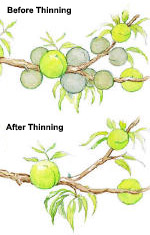 Examine leaves of apple and cherry, and fruit of peach/nectarine, for powdery mildew lesions. Apply a fungicide where necessary to prevent additional spread.
Examine leaves of apple and cherry, and fruit of peach/nectarine, for powdery mildew lesions. Apply a fungicide where necessary to prevent additional spread.- Thin apples when they are 1/2-inch in diameter, and thin peaches now, or in the next few weeks (earlier is better). On apples, thin clusters to one apple and to six inches apart. Thin peaches to 4 to 6 inches apart.
APPLE, PEAR
Codling Moth
Codling moth treatment dates updated for northern Utah locations.
View a pdf of the spray timing table. Be sure to read the instructions at the top of the page, for how to read the table.
Treatment
- See this post for a table of spray options for backyard growers (scroll down).
- Options for commercial growers.
Pear Fruit Sawfly
We have had many reports of damage to pear that resembles codling moth, especially from the Utah County area. The pest is the non-native, pear fruit sawfly. See this post from March 24 for more information on this pest (scroll down to the bottom of the page). Right now, there is nothing to be done except to remove and destroy any infested fruits.
Woolly Apple Aphid
Aphid colonies are growing; treat early for best control
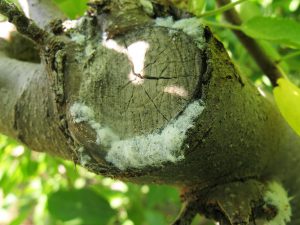
Woolly apple aphids are showing up in the warmer areas of the Wasatch Front. It is important to scout your own trees to determine when and if a treatment is needed. Start by looking for aphids around old pruning scars or other wounds, and on root suckers.
These aphids are different from typical aphid species in that they feed on twigs, bark and roots, and have a cottony covering on their bodies.
Treatment
If woollies are a problem every year, it is best to treat them early. Because of the aphid’s thick, waxy coating, it is important to spray the tree to drip, to reach the aphid bodies.
- Backyard growers can use insecticidal soap+1% oil (organic), or mix 1% oil with Spectracide Triazicide or GardenTech Sevin, aimed directly at the colonies.
- Options for commercial growers
Appleleaf and Pearleaf Blister Mites
Moderate amounts of blisters do not reduce the vigor of the plant or affect fruit
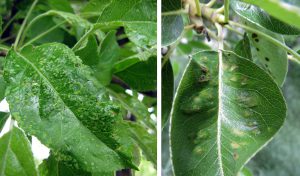
We have had reports of “spots” appearing on apple and pear leaves. These are actually tiny blisters, and inside each one are hundreds of microscopic mites called blister mites. The minute, 4-legged mites feed inside the blisters all summer.
On apple leaves, the blisters age to brown, and on pear leaves, they age to a dark brown/black. After harvest, the mites leave the blisters and migrate to leaf buds to spend the winter.
Note that there is nothing to do for treatment at this time of year, but an application after harvest and close to leaf drop will help.
Materials to apply after harvest include carbaryl, sulfur, or oil.
Fire Blight – Post-Infection
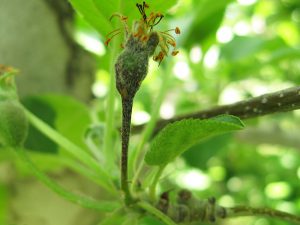
Inspect fruit clusters starting 2 weeks after full bloom for infections
We are seeing some fire blight infections in northern Utah. They typically be visible 2 to 3 weeks after full bloom. It is important to monitor your apple and pear trees every week. Look for wilted leaves, and fruit clusters that appear shriveled and brown.
Post-infection Treatment
- Prune out all diseased plant parts as they are found. This will not only prevent the infections from expanding into the tree, but will also reduce the source of bacteria in the area.
-
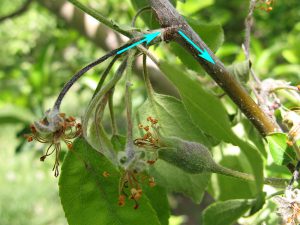
This fire blight infection is about 3 to 4 weeks old. The bacteria has already entered the branch, so it should be pruned 12 inches below the visible canker. For infections that are caught early, remove twice the length of the visible symptoms.
- For infections that are caught late (that have expanded beyond the fruit cluster), it is important to make the pruning cut 10 to 12 inches beyond the visible symptoms.
- Prune in dry weather only. To be safe, wipe pruners with disinfecting wipes between cuts.
If moisture is predicted after pruning, remove the debris rather than leaving it in the orchard. If conditions are hot and dry, it is OK to leave the debris on the ground.
PEACH/NECTARINE, APRICOT
Peach Aphids
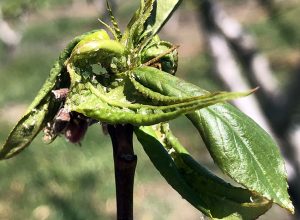
It is that time of year for green peach aphids, and they seem to be everywhere. The aphids overwinter as eggs, and hatch around the time of bud break. They will spend the next few weeks feeding on the undersides of the foliage, and then migrate away to summer hosts (vegetable plants and weeds).
Backyard trees can tolerate the aphid activity. This will help preserve and promote beneficial insects.
Treatment
- If necessary, residential growers can use insecticidal soap, but the soap must come into contact with the aphids, as they are tucked tightly within the leaf curls.
- Commercial growers can use Admire Pro, or a generic.
Peach Twig Borer
Nearing time to treat in some Utah locations
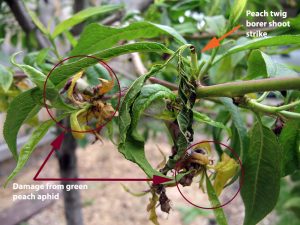
Peach twig borer affects peaches, nectarines, and apricots. Unlike codling moth on apples, this pest is more sporadic in Utah, and some locations have a low enough population that does not need to be treated.
Peach twig borer larvae prefer to feed inside leaf shoots. Later in the season, when twigs become hardened off and unpalatable, larvae enter fruit as the “second best option.” In short, the first generation bores into succulent twigs (hence, its name) while later generations move on to the ripening fruit.
Dates for locations we know:
- Capitol Reef: May 27 – 31
- Farmington: June 2 – June 6
- Kanab: May 29 – June 1
- Leeds: May 16 – 18
- Moab: May 24 – 27
- Provo Airport: June 1 – 5
- Salt Lake City (warmer locations): June 2 – 6
Sprays for the first generation will protect shoots from being attacked while later sprays will protect fruit from being attacked.
Treatment
- Commercial: It is time to hang mating disruption dispensers in northern Utah locations. Southern Utah locations that have treatment timing coming up can click here.
- Residential: Treatment options are the same as for codling moth.
CHERRY
Western Cherry Fruit Fly
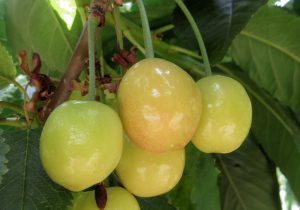
Treatment for western cherry fruit fly—the worms in the fruit—should begin as soon as cherries develop a salmon blush color. Tart cherries in most locations are still green, while sweets will be coloring up quickly with the upcoming warm weather.
It is important to monitor your own trees for color change.
Treatment Options – Backyard Growers
Conventional:
- Malathion (malathion): every 7 days
- Bonide Fruit Tree Spray (carbaryl): every 14 days
- GardenTech Sevin, Spectracide Triazicide: every 14 days
Organic:
- Fertilome / Gardens Alive / Bull’s Eye / Monterey (spinosad): every 7 days
- Safer BioNEEM (azadirachtin): every 7 to 10 days
Treatment – Commercial Growers
- Commercial growers, click here.
